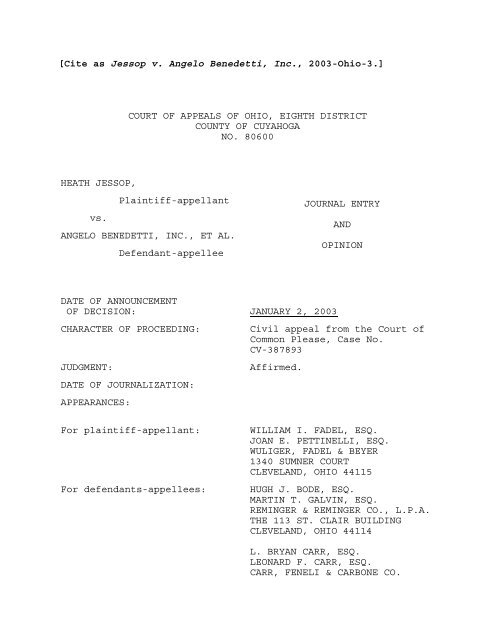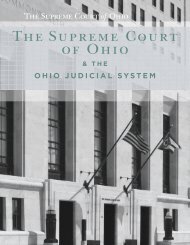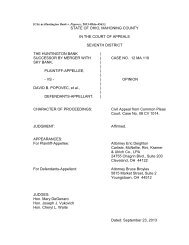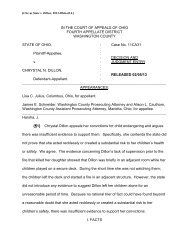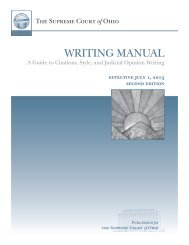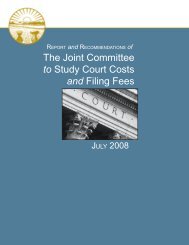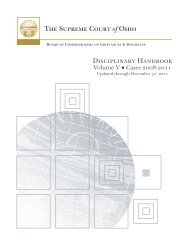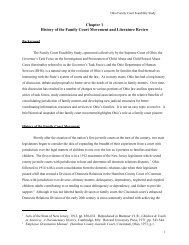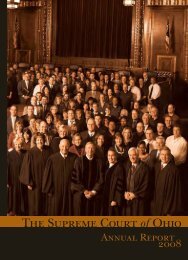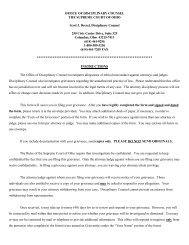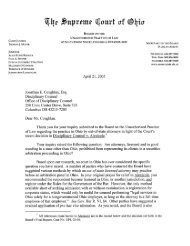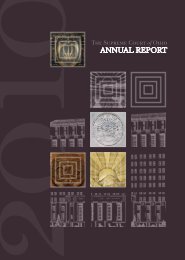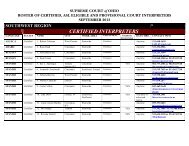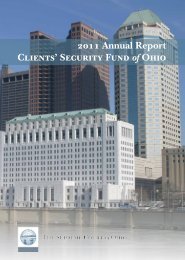Jessop v. Angelo Benedetti, Inc. - Supreme Court
Jessop v. Angelo Benedetti, Inc. - Supreme Court
Jessop v. Angelo Benedetti, Inc. - Supreme Court
You also want an ePaper? Increase the reach of your titles
YUMPU automatically turns print PDFs into web optimized ePapers that Google loves.
[Cite as <strong>Jessop</strong> v. <strong>Angelo</strong> <strong>Benedetti</strong>, <strong>Inc</strong>., 2003-Ohio-3.]<br />
HEATH JESSOP,<br />
vs.<br />
COURT OF APPEALS OF OHIO, EIGHTH DISTRICT<br />
COUNTY OF CUYAHOGA<br />
NO. 80600<br />
Plaintiff-appellant<br />
ANGELO BENEDETTI, INC., ET AL.<br />
Defendant-appellee<br />
DATE OF ANNOUNCEMENT<br />
OF DECISION:<br />
CHARACTER OF PROCEEDING:<br />
JUDGMENT:<br />
DATE OF JOURNALIZATION:<br />
APPEARANCES:<br />
For plaintiff-appellant:<br />
For defendants-appellees:<br />
JANUARY 2, 2003<br />
JOURNAL ENTRY<br />
AND<br />
OPINION<br />
Civil appeal from the <strong>Court</strong> of<br />
Common Please, Case No.<br />
CV-387893<br />
Affirmed.<br />
WILLIAM I. FADEL, ESQ.<br />
JOAN E. PETTINELLI, ESQ.<br />
WULIGER, FADEL & BEYER<br />
1340 SUMNER COURT<br />
CLEVELAND, OHIO 44115<br />
HUGH J. BODE, ESQ.<br />
MARTIN T. GALVIN, ESQ.<br />
REMINGER & REMINGER CO., L.P.A.<br />
THE 113 ST. CLAIR BUILDING<br />
CLEVELAND, OHIO 44114<br />
L. BRYAN CARR, ESQ.<br />
LEONARD F. CARR, ESQ.<br />
CARR, FENELI & CARBONE CO.
KARPINSKI, J.:<br />
1392 SOM CENTER ROAD<br />
MAYFIELD HTS., OHIO 44124<br />
{¶1} Plaintiff-appellant, Heath <strong>Jessop</strong> is appealing the trial<br />
court granting summary judgment to defendants-appellees, <strong>Angelo</strong><br />
<strong>Benedetti</strong>, <strong>Inc</strong>. and <strong>Angelo</strong> <strong>Benedetti</strong>, Jr., president of <strong>Benedetti</strong><br />
<strong>Inc</strong>. (collectively, “defendant”). Plaintiff is specifically<br />
appealing “the grant of summary judgment on appellant’s statutory<br />
strict products liability claims, Counts II, IV and VI of the<br />
Amended Complaint.” (Plaintiff’s brief at 5). For the reasons<br />
that follow, we affirm the judgment of the trial court.<br />
{¶2} On August 5, 1998, plaintiff was working for defendant in<br />
its asphalt paving business. Plaintiff was told to enter one of<br />
defendant’s large pieces of paving equipment called a “Drum Mixer<br />
Recycler 2" (the “Machine”) in order to service/clean it. The<br />
parties agree that the defendant designed and fabricated the<br />
Machine for use in its business.<br />
{¶3} The record shows that in addition to developing the<br />
Machine, defendant also developed other pieces of equipment used in<br />
its business, including some pieces that were offered for sale as<br />
used equipment in industry magazines. There is no evidence,<br />
however, that the Machine was ever advertised for sale to the<br />
public.
{¶4} On August 5 th , after plaintiff entered the Machine, his<br />
boot became caught in one of the machine’s rotating auger blades.<br />
Plaintiff suffered severe injuries, including the eventual partial<br />
amputation of his leg.<br />
{¶5} After applying for and receiving workers compensation<br />
benefits, plaintiff filed a lawsuit against defendant in which he<br />
asserted a variety of claims. 1 Pertinent to the issues before this<br />
court are plaintiff’s claims for strict products liability based on<br />
design defect (count II), strict products liability based on<br />
failure to warn/instruct (count IV), and, strict products liability<br />
based upon manufacturing defects (count VI). On all three claims,<br />
plaintiff’s complaint alleges defendant is liable to him under the<br />
“dual capacity doctrine” and thus defendant cannot assert employer<br />
immunity 2 in defense to claims sounding in strict products<br />
liability. Defendant filed a motion for summary judgment in which<br />
it argued that, under Civ.R. 56, plaintiff’s strict products<br />
liability claims (counts II, IV, and VI) had to be dismissed<br />
because plaintiff could not meet his evidentiary burden showing<br />
that the dual capacity doctrine applied to either defendant.<br />
1 Plaintiff filed an amended complaint on June 20, 2000. It is<br />
this amended complaint and three of the claims set forth therein<br />
(counts II, IV, VI) which are the subject of this appeal. Apart<br />
from the claims at issue here, plaintiff also asserted six other<br />
claims which are not part of this appeal. On November 19, 2002,<br />
the trial court determined there was no just reason for delaying<br />
this appeal.<br />
2<br />
See the Workers’ Compensation Act, specifically R.C. 4123.74<br />
and 4123.741.
{¶6} Defendant further argued that, as a matter of law,<br />
plaintiff’s claims were also barred because under the workers’<br />
compensation statutes, R.C. 4123.74 and R.C. 4123.741, both<br />
defendants had immunity, which could not be disturbed by the dual<br />
capacity doctrine because the Industrial Commission had previously<br />
deemed plaintiff’s injuries compensable.<br />
{¶7} The trial court agreed with defendant and granted its<br />
motion for summary judgment. The trial court gave two reasons in<br />
its order. The court determined that plaintiff had not met his<br />
evidentiary burden under Civ.R. 56 because he was unable to show<br />
that the dual capacity doctrine applied to the facts in the case.<br />
The court also determined that, regardless of the dual capacity<br />
doctrine, both defendants had immunity as a matter of law, because<br />
plaintiff applied for and was receiving workers’ compensation<br />
benefits. Accordingly, the court granted summary judgment to<br />
defendant on plaintiff’s strict products liability claims, counts<br />
II, IV, and VI, of the complaint. 3<br />
{¶8} Plaintiff filed this timely appeal in which he presents<br />
four assignments of error, all of which are related to the trial<br />
3 In granting defendant’s motion for summary judgment, the<br />
trial court also granted summary judgment to defendant on three of<br />
plaintiff’s claims, including counts III, V, and VII, all of which<br />
alleged defendant’s liability in common law negligence for<br />
defective product. The court, however, did not rule on count I of<br />
plaintiff’s complaint for intentional tort against defendant or<br />
counts VIII & IX against unknown John Doe defendants for supplier<br />
liability. During the pendency of this appeal, these three claims<br />
are stayed.
court granting summary judgment to defendant. Because plaintiff’s<br />
first two assignments of error relate to his products liability<br />
claims and the dual capacity doctrine, we will address them<br />
together.<br />
{¶9} FIRST ASSIGNMENT OF ERROR-THE TRIAL COURT ERRED IN<br />
GRANTING SUMMARY JUDGMENT TO DEFENDANT-APPELLEES ON PLAINTIFF-<br />
APPELLANT’S CLAIMS FOR STRICT PRODUCT LIABILITY BROUGHT UNDER OHIO<br />
REVISED CODE 2307.71 ET SEQ.<br />
{¶10} SECOND ASSIGNMENT OF ERROR-THE TRIAL COURT ERRED IN<br />
APPLYING THE OHIO SUPREME COURT’S DECISION IN SCHUMP V. FIRESTONE<br />
TIRE & RUBBER CO., IN VIOLATION OF PUBLIC POLICY AND IN DEROGATION<br />
OF THE LEGISLATIVE INTENT OF THE WORKERS’ COMPENSATION ACT.<br />
{¶11} According to plaintiff, the trial court erred by<br />
granting defendant summary judgment because there remain genuine<br />
issues of material fact on whether, under the dual capacity<br />
doctrine, (1) defendant, as his employer, nonetheless, also<br />
occupied a separate identity as the designer and manufacturer of<br />
the Machine under R.C. 2307.71 et seq.; and (2) plaintiff was<br />
injured while acting within the scope of his employment.<br />
{¶12} Plaintiff also claims that summary judgment was<br />
unwarranted because R.C. 4123.74 or 4123.741 is unconstitutional<br />
insofar as it grants immunity to his employer. The standard of<br />
review of a grant or denial of summary judgment is the same for<br />
both a trial court and an appellate court: on appeal, therefore,
the review is de novo. Lorain Natl. Bank v. Saratoga Apts. (1989),<br />
61 Ohio App.3d 127, 129, 572 N.E.2d 198. Rule 56(C) of the Ohio<br />
Rules of Civil Procedure provides that summary judgment is proper<br />
only if the trial court determines that: (1) no genuine issue as to<br />
any material fact remains to be litigated; (2) the moving party is<br />
entitled to judgment as a matter of law; and (3) it appears from<br />
the evidence, viewed most strongly in favor of the non-moving<br />
party, that reasonable minds can come to but one conclusion and<br />
that conclusion is adverse to that party. Temple v. Wean United,<br />
<strong>Inc</strong>. (1977), 50 Ohio St.2d 317, 327, 364 N.E.2d 267.<br />
{¶13} Under the rule and the controlling case law of Ohio,<br />
the moving party must support the motion with affirmative evidence<br />
in order to meet its burden of proving that no genuine issue of<br />
material fact exists for trial. Dresher v. Burt (1996), 75 Ohio<br />
St.3d 280, 662 N.E.2d 264; Fyffe v. Jeno’s, <strong>Inc</strong>. (1991), 59 Ohio<br />
St.3d.115, 510 N.E.2d 1108. The burden of establishing that no<br />
genuine issues as to any material fact remain to be litigated is on<br />
the party moving for summary judgment. Turner v. Turner (1993), 67<br />
Ohio St.3d 337, 340, 617 N.E.2d 1123; Fyffe, supra. Once a party<br />
moves for summary judgment and has supported the motion by<br />
sufficient and acceptable evidence, the party opposing the motion<br />
has a reciprocal burden to respond by affidavit or as otherwise<br />
provided in Civ.R. 56(C), setting forth specific facts explaining<br />
that a genuine issue of material fact exists for trial. Jackson v.
Alert Fire & Safety Equip., <strong>Inc</strong>. (1991), 58 Ohio St.3d 48, 52, 567<br />
N.E.2d 1027; Mitseff v. Wheeler (1988), 38 Ohio St.3d 112, 115, 526<br />
N.E.2d 798.<br />
{¶14} A motion for summary judgment forces the nonmoving<br />
party to produce evidence on all issues for which that party bears<br />
the burden of production at trial. Wing v. Anchor Media, Ltd. of<br />
Texas (1991), 59 Ohio St.3d 108, 570 N.E.2d 1095. However, it is<br />
the moving party who bears the initial responsibility of informing<br />
the trial court of the basis for the motion and identifying those<br />
portions of the record which demonstrate the absence of a genuine<br />
issue of fact on a material element of the nonmoving party's<br />
claim. Dresher, supra.<br />
{¶15} Typically, claims related to injuries sustained in<br />
the course of employment are addressed exclusively by the Ohio's<br />
Workers' Compensation statutes. 4 See Johnson v. BP Chems., <strong>Inc</strong>.,<br />
(1999) 85 Ohio St.3d 298, 707 N.E.2d 1107.<br />
{¶16} In the case at bar, however, plaintiff contends that<br />
defendant acted in a dual capacity; defendant acted as his employer<br />
and the designer/manufacturer of the Machine. Under this doctrine,<br />
plaintiff claims that because defendant designed and developed the<br />
Machine, defendant no longer functioned merely as his employer, but<br />
acted, rather, in the separate and distinct capacity of a<br />
4 An exception to the exclusive nature of worker’s compensation<br />
law is the intentional tort claim an employee may assert against an<br />
employer.
designer/manufacturer under R.C. 2307.71 et seq.<br />
{¶17} According to plaintiff, because defendant stepped<br />
outside the role of employer when it developed the Machine,<br />
plaintiff should be permitted to pursue his products liability<br />
claims against defendant, just like any other person who suffers<br />
harm because of a defective product. Plaintiff insists the dual<br />
capacity doctrine applies to the facts in this case and, even<br />
though he applied for and has been receiving workers’ compensation<br />
benefits, defendant should not have immunity simply because it paid<br />
premiums into the workers’ compensation fund. Plaintiff maintains<br />
thus that under the dual capacity doctrine defendant can be held<br />
strictly liable under R.C. 2307.71 et seq., Ohio’s products<br />
liability statute.<br />
{¶18} R.C. 2307.01 states that a manufacturer or a<br />
supplier may be held strictly liable for a "product" under certain<br />
conditions. R.C. 2307.71 defines a "product" as "any object,<br />
substance, mixture, or raw material that constitutes tangible<br />
personal property and that satisfies all the following: “(a) It is<br />
capable of delivery itself, or as an assembled whole in a mixed or<br />
combined state, or as a component or ingredient; (b) It is<br />
produced, manufactured, or supplied for introduction into trade or<br />
commerce; (c) It is intended for sale or lease to persons for<br />
commercial or personal use.”<br />
{¶19} As a threshold matter, we note that plaintiff has
not presented any evidence that the Machine, in any way, satisfies<br />
the statute’s definition of “product.” To the contrary, the<br />
undisputed evidence shows that defendant designed and developed the<br />
Machine for exclusive use by its employees solely in its paving<br />
business. In the record before us, there is no evidence satisfying<br />
Civ.R. 56, to indicate the Machine was ever “produced,<br />
manufactured, or supplied for introduction into trade or commerce”<br />
or “intended for sale or lease to persons for commercial or<br />
personal use.” The mere fact that defendant developed the Machine,<br />
without more, is simply not enough evidence to establish the<br />
Machine as a “product” under the statute. On this point alone,<br />
plaintiff’s statutory claims against defendant for strict products<br />
liability fail completely.<br />
{¶20} Even assuming the Machine did qualify as a “product”<br />
under the statute, plaintiff does not meet the requisite test under<br />
the dual capacity doctrine and Civ.R. 56. Under Ohio law,<br />
employers who comply with the Workers' Compensation Act are granted<br />
immunity from civil liability for unintentional employment-related<br />
injuries. In relevant part, R.C. 4123.74 states: “Employers who<br />
comply with Section 4123.35 of the Revised Code shall not be liable<br />
to respond to damages at common law or by statute for any injury<br />
*** received or contracted by any employee in the course of or<br />
arising out of his employment ***.”<br />
{¶21} In the case at bar, plaintiff argues that statutory
immunity pursuant to R.C. 4123.74 is inapplicable under the dual<br />
capacity doctrine. This doctrine is a narrow exception to employer<br />
immunity under workers’ compensation. Under the dual capacity<br />
doctrine, “an employer normally shielded from tort liability ***<br />
may become liable in tort to his own employee if he occupies *** a<br />
second capacity that confers on him obligations independent of<br />
those imposed as employer.” 5 Freese v. Consolidated Rail Corp.<br />
(1983), 4 Ohio St.3d 5, 8, 445 N.E.2d 1110, 1112.<br />
{¶22} The Ohio <strong>Supreme</strong> <strong>Court</strong> explained, in order for an<br />
employer to fall within the dual capacity doctrine, “it must step<br />
outside the boundaries of the employer-employee relationship,<br />
creating separate and distinct duties to the employee; the fact of<br />
injury must be incidental to the employment relationship.” Schump<br />
v. Firestone Tire & Rubber Co. (1989), 44 Ohio St.3d 148, 152, 541<br />
N.E.2d 1040, 1044-45.<br />
{¶23} Furthermore, “in order for the dual-capacity<br />
doctrine to apply, there must be an allegation and showing that the<br />
employer occupied two independent and unrelated relationships with<br />
the employee, that at the time of these roles of the employer there<br />
were occasioned two different obligations to this employee, and<br />
5 R.C. 4123.01(A)(1) and (B) defines the terms “employee” and<br />
“employer.” R.C. 4123.01(A)(1)(b) defines "employee" in pertinent<br />
part as follows: “Every person in the service of any person, firm,<br />
or private corporation, including any public service corporation,<br />
that (i) employs one or more workmen or operatives regularly in the<br />
same business or in or about the same establishment under any<br />
contract of hire, express or implied, oral or written ***.”
that the employer had during such time assumed a role other than<br />
that of employer.” Schump, supra at 151.<br />
{¶24} If, however, the injury is caused predominantly by<br />
the employment relationship and not by an independent relationship,<br />
the doctrine of dual capacity is inapplicable. Schump, supra; See,<br />
Bakonyi v. Ralston Purina Co. (1985), 17 Ohio St.3d 154, 157-58,<br />
478 N.E.2d 241.<br />
{¶25} In Schump, for example, the worker was employed as a truck driver at a<br />
Firestone Retread Center. He was injured when a front tire on his truck blew out. The tire<br />
was manufactured by Firestone. As in the case at bar, the employer had designed and<br />
manufactured the device that caused his injury. The <strong>Supreme</strong> <strong>Court</strong> enunciated the<br />
following principle: “it is universally held that where an employer designs and<br />
manufactures a product for use by its employees and not for sale to the general public, an<br />
employee injured while using that product within the scope of his employment may not<br />
maintain a products liability action against his employer under the dual-capacity doctrine on<br />
the theory that the employer assumed an independent role as manufacturer.”<br />
{¶26} The <strong>Supreme</strong> <strong>Court</strong> discussed the public policy considerations in holding<br />
manufacturers accountable for injuries occasioned by product defects. However, the<br />
<strong>Supreme</strong> <strong>Court</strong> explained, “to allow an employee to sue his employer for injuries which are<br />
predominately work-related, and for which, as here, the employee has received workers’<br />
compensation benefits, would be to elevate the public policy on which products liability is<br />
based over the constitutional imperative contained in Section 35, Article II of the Ohio<br />
Constitution,” which provides for workers’ compensation benefits.
{¶27} The court provided the following analysis: What “‘matter[s] is that, as to this<br />
employee, the product was manufactured as an adjunct of the business, and furnished to<br />
him solely as an employee, not as a member of the consuming public. What the employer<br />
does with the rest of his output could not change this central fact. ***’ (Emphasis sic.)”<br />
Schump, citing 2A Larson, Law of Workmen’s Compensation (1988), at 14-241, Section<br />
72.81(c).<br />
{¶28} In the case at bar, plaintiff contends that, when he was injured by the<br />
Machine developed by defendant, defendant at that moment occupied an independent<br />
relationship to him apart from its role as his employer. When he was injured, plaintiff<br />
maintains, defendant assume the independent role of designer/manufacturer of a defective<br />
product, namely, the Machine.<br />
{¶29} Specifically, plaintiff argues that the instruction to service the Machine fell<br />
outside the parameters of his actual job responsibilities as a “pre-heater” operator and<br />
thus he could not have been using the Machine within the scope of his employment. We<br />
disagree.<br />
{¶30} First, plaintiff has not produced any evidence that he had a job description or<br />
responsibilities which did not allow him to service the Machine. Plaintiff’s conclusory<br />
statement is unsupported by the type or quality of evidence required by Civ.R. 56.<br />
{¶31} Second, the issue is not whether he was in the “scope of employment.”<br />
There is no dispute that the employer made the Machine in which he was injured<br />
accessible to the worker and ordered him to work on the Machine. 6 Whether his duties<br />
6 Plaintiff’s own expert describes plaintiff as having been<br />
injured while at work. (Harkness affidavit para. 10)
were different or other than normal, they were, nevertheless, duties performed at the<br />
direction of his employer, and the employer’s conduct arose out of the employment<br />
relationship. The Machine in the case at bar can be analyzed in the same way the<br />
<strong>Supreme</strong> <strong>Court</strong> analyzed the Firestone tires in Schump, supra: the Machine “was<br />
furnished to [him] solely as an employee, not as a member of the consuming public.”<br />
Schump, supra at 152.<br />
{¶32} Plaintiff mistakenly relies upon Blackburn v. Jobst Institutes, <strong>Inc</strong>. (July 19,<br />
1991) Lucas App. No. L-90-130. In Blackburn the worker was diagnosed with phlebitis of<br />
the right leg and Raynaud’s Syndrome. She claimed that her condition resulted from<br />
wearing custom-made support hose around the plant for several hours per day at the<br />
request of her employer to test the stockings. The employer responded that the worker<br />
was hired to handle customer complaints, not to test stockings. The worker maintained<br />
that she was injured in her role as a consumer while the employer was functioning in its<br />
role as manufacturer. The trial court decided there was no dual capacity, on the basis that<br />
she had accepted workers’ compensation benefits for her injuries. Finding that reason<br />
erroneous, the appellate court observed that the Industrial Commission had never ruled on<br />
whether the worker’s eligibility arose from her stocking-testing duties as opposed to her<br />
duties as a clerical worker. Thus the issue in Blackburn, that is, reliance upon the<br />
Commission decision, was not the same as in the case at bar.<br />
{¶33} The Sixth District correctly explained that “it is possible for an employee to<br />
bring a cause of action in tort against an employer even though the employee was pursuing<br />
the employer’s business at the time of the injury and had been awarded workers’<br />
compensation benefits. Walker v. Mid-States Terminal (1984), 17 Ohio App.3d 19.”
Blackburn at 3. Further citing Walker, the court explained: “‘The intentional tort claim was<br />
allowed based on the distinction ‘whether the employer’s conduct arose out of the<br />
employment and not whether the injury occurred in the course of employment.’ Id. At 25.<br />
{¶34} Given all the foregoing evidence, we must conclude, as did the trial court,<br />
that there are no genuine issues of material fact about whether defendant’s conduct arose<br />
out of the plaintiff’s employment relationship. From the record before us, reasonable<br />
minds can conclude only that the Machine was furnished to plaintiff solely as an employee<br />
when he was injured. Consequently, the trial court did not err in granting defendants’<br />
motion for summary judgment and in thereby determining that the dual capacity doctrine<br />
did not apply to the facts in this case and that plaintiff’s statutory claims against defendant<br />
for strict products liability have no merit.<br />
{¶35} In addition, plaintiff argues the trial court erred in deciding that the dual<br />
capacity doctrine did not apply to defendant, Mr. <strong>Benedetti</strong>, personally 7 because Mr.<br />
<strong>Benedetti</strong> was a “fellow employee” who had the same immunity as the company under<br />
R.C. 4123.741.<br />
{¶36} R.C. 4123.01(A)(1) and (B) define the terms “employee”<br />
and “employer.” R.C. 4123.01(A)(1)(b) defines "employee" in<br />
pertinent part as follows: “Every person in the service of any<br />
person, firm, or private corporation, including any public service<br />
corporation, that (i) employs one or more workmen or operatives<br />
regularly in the same business or in or about the same<br />
7 Plaintiff’s claims against Mr. <strong>Benedetti</strong>, individually, sound<br />
in strict products liability because he developed the Machine.
establishment under any contract of hire, express or implied, oral<br />
or written ***.” Plaintiff claims that if an employee occupies a supervisory or<br />
management-type position, then that employee cannot avail himself of the statute’s<br />
immunity. We reject this argument.<br />
{¶37} Generally, the dual capacity doctrine applies to any employee of an<br />
“employer” defined in R.C. 4123.74. R.C. 4123.741 provides the same kind<br />
of immunity to any individual employee of an employer who<br />
participates in the state’s workers’ compensation fund. See,<br />
4123.01(B). Under the plain language of the statute, regardless of an employee’s rank,<br />
The Workers Compensation Act’s definition of "employee" applies to "every person" in the<br />
service of an employer ***.” Smith v. Westside Community House (Dec. 26, 1991),<br />
Cuyahoga App. No. 59306, citing Jarvis v. Schindler (1984), 20 Ohio App.3d 227.<br />
{¶38} Plaintiff’s first two assignments of error are overruled.<br />
{¶39} THIRD ASSIGNMENT OF ERROR-THE TRIAL COURT ERRED IN<br />
APPLYING OHIO REVISED CODE 4123.74 AND 4123.741 IN VIOLATION OF<br />
PLAINTIFF-APPELLANTS [sic] RIGHT TO AN ADEQUATE REMEDY UNDER ARTICLE I,<br />
SECTION 16 OF THE OHIO CONSTITUTION.<br />
{¶40} FOURTH ASSIGNMENT OF ERROR-THE TRIAL COURT ERRED IN<br />
APPLYING OHIO REVISED CODE 4123.74 AND 4123.741 IN VIOLATION OF<br />
PLAINTIFF-APPELLANT’S RIGHT TO EQUAL PROTECTION UNDER THE<br />
FOURTEENTH AMENDMENT TO THE UNITED STATES CONSTITUTION AND<br />
ARTICLE I, SECTION 2 OF THE OHIO CONSTITUTION.<br />
{¶41} According to plaintiff, the application of both workers’ compensation statutes
R.C. 4123.74 and 4123.741, under the facts of this case, violates the Ohio Constitution.<br />
First, plaintiff argues that the workers’ compensation statutes deny him an adequate<br />
remedy because they do not account for his pain and suffering and any punitive damages.<br />
Plaintiff also argues that “precluding an employee from maintaining a products liability<br />
action” solely because of his status as an employee violates the equal protection clause<br />
both of the United States Constitution and of the Ohio Constitution, because the statutes<br />
treat him differently because he is an employee. Plaintiff, however, offers no legal<br />
authority for this position, nor do we find any such authority.<br />
{¶42} Plaintiff is correct in his understanding that workers’ compensation was<br />
enacted as a “trade-off” “to relieve employees of the burden to prove negligence and<br />
eliminate the common law defenses to negligence liability.” Brief p. 31. In that trade off,<br />
remedies were limited. What plaintiff has ignored, however, is that by means of the<br />
intentional tort the courts have expanded the remedies for workers when the danger the<br />
worker is exposed to is a result of more than negligence. Under intentional tort, the worker<br />
could be compensated for his pain and suffering and also receive punitive damages.<br />
Plaintiff, therefore, has failed to show how the remedies available to him are inadequate.<br />
{¶43} Moreover, plaintiff has not produced any evidence that the Machine is a<br />
“product” under the products liability statute, R.C. 2307.71 et seq. 8 Without a “product,”<br />
plaintiff has no standing to challenge the constitutionality of either statute. “It is<br />
rudimentary that, in order for one to have a right to challenge a statute upon a<br />
8 Nor need we address the merits of the earlier argument<br />
regarding the adequacy of the remedy, because that claim also rests<br />
on a claim of product liability.
constitutional basis, the person posing such a challenge must, in fact, be adversely<br />
affected by that statute. Palazzi v. Estate of Gardner (1987), 32 Ohio St.3d 169, 512<br />
N.E.2d 971." McKenney v. Hillside Dairy Cc. (1996), 109 Ohio App.3d 164, 175, 671<br />
N.E.2d 1291. The Palazzi court held "the constitutionality of a state statute may not be<br />
brought into question by one who is not within the class against whom the operation of the<br />
statute is alleged to have been unconstitutionally applied and who has not been injured by<br />
its alleged unconstitutional provision." Palazzi id., syllabus. Standing to challenge the<br />
constitutionality of a statute requires demonstration of concrete injury in fact, rather than an<br />
abstract or suspected injury. State ex rel. Consumers League of Ohio v. Ratchford (1982),<br />
8 Ohio App.3d 420, 424, 457 N.E.2d 878.” State v. Barnes (Jan. 11, 2001), Cuyahoga<br />
App. No. 77078.<br />
{¶44} In the case at bar, plaintiff claims to be adversely affected by both statutes<br />
because they prevent him from suing either defendant for strict products liability under R.C.<br />
2307.71 et seq. We have already determined that the Machine is not a “product” under<br />
the strict products liability statutes. Without a “product,” plaintiff is unable to show an<br />
adverse effect related to either statute. Accordingly, Plaintiff does not have standing to<br />
challenge the constitutionality of either R.C. 4123.74 or 4123.741.<br />
{¶45} Plaintiff’s third and fourth assignments of error are overruled. The judgment<br />
of the trial court is affirmed.<br />
It is ordered that appellees recover of appellant their costs herein taxed.<br />
The court finds there were reasonable grounds for this appeal.<br />
It is ordered that a special mandate issue out of this court directing the Common<br />
Pleas <strong>Court</strong> to carry this judgment into execution.
A certified copy of this entry shall constitute the mandate pursuant to Rule 27 of the<br />
Rules of Appellate Procedure.<br />
PATRICIA A. BLACKMON, P.J., and<br />
TERRENCE O’DONNELL, J., CONCUR.<br />
DIANE KARPINSKI<br />
JUDGE<br />
N.B. This entry is an announcement of the court's decision. See App.R. 22(B),<br />
22(D) and 26(A); Loc.App.R. 22. This decision will be journalized and will become the<br />
judgment and order of the court pursuant to App.R. 22(E) unless a motion for reconsideration<br />
with supporting brief, per App.R. 26(A), is filed within ten (10) days of the<br />
announcement of the court's decision. The time period for review by the <strong>Supreme</strong> <strong>Court</strong> of<br />
Ohio shall begin to run upon the journalization of this court's announcement of decision by<br />
the clerk per App.R. 22(E). See, also, S.Ct.Prac.R. II, Section 2(A)(1).


